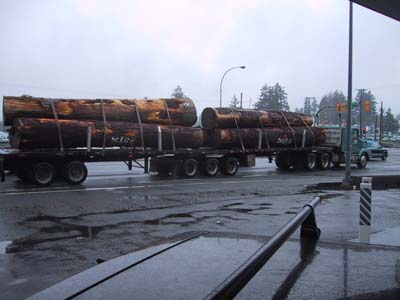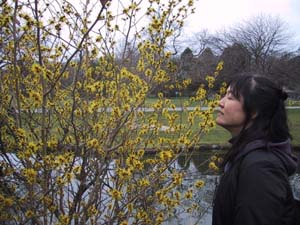Metamorphosis


I’ve been driving due south, straight as an arrow for hours, through an endless, landscape of clear-cut rainforest, the sky the colour of lead, the highway slick with rain. Giant logging trucks send up huge rooster tails of slimy spray that settles on my windshield. The frenetic slapping of my hapless wiper blades can barely keep up. Most of the trucks carry loads of spindly second-growth fir, but I am shocked to be passed by one carrying logs from ancient, old-growth trees, probably over 300 years in age. Such loads are becoming rarer now that most of British Columbia’s ancient coastal forest has been liquidated, much of it in my own lifetime. It is hard to believe that the monotonous and ravaged landscape through which I have been driving was once completely covered with such giant trees, among the tallest on earth. Occasionally a ragged eagle flaps up from the broken-off snag of some ancient conifer, somehow left behind in the initial logging frenzy. It amazes me that eagles can still survive here. These enormous raptors seem like they are from another age. Maybe they’ve learned how to eat garbage. . . The highway is lined on both sides by a 3 metre tall fence, an impenetrable barrier to keep terrestrial wildlife off the road. It must be a powerful deterent. I’ve driven down this desolate highway dozens of times and have never seen a deer or one of Vancouver Island’s disappearing elk, anywhere near it. There is even a band of fine wire mesh at the fence’s base to keep out inquisitive rabbits. The old Subaru’s engine reeks of burning oil and carbon monoxide as it strains to maintain the 120 kph cruising speed.
Finally, pulling into Victoria, I slow down enough to see the snowdrops blooming, incongrously white in the dun metallic light of the late January afternoon. The pink flowers of Viburnum bodnantense, the colour of Barbie flesh and the spidery yellow little firework explosions of Chinese witchhazel glint out from behind the glossy green hedges of this surreal, faux England. I come to the end of the road, park the car and walk down to a limpid gray sea. In the distance, past the bobbing beds of kelp, past the invisible shipping lanes plied by endless convoys of container ships stuffing the maw of a million Wal Marts, looms the darkness of the Olympic peninsula. The sullen mass of America. Above it floats a faint, lens-shaped orange glow of what, were it not for the all-pervasive gloom, might pass for a sunset. The eye of Sauron?

Chinese witch hazel |
I’ve come to Victoria to attend Phillip Glass’s piano recital. Now, I’ve always thought that Mr. Glass was kind of a one trick pony. But what a magnificent trick! The mesmerizing tinkling, the mesmerizing tinkling, the mesmerising tinkling . . . . woven in and out by what can only be described as sonic musings. The notes develop the consistency of October rain falling on the Pacific. A scintillating pitter patter modulated by rolling, swell-like undulations. I am carried away by Witchita Vortex Sutra, written by Glass as an accompaniment to the words of Allan Ginsberg in 1973, during which Ginsberg declared the end of the Vietnam War while standing at the exact geographic centre of the United States of America. The war didn’t end with the utterance of this poem but maybe it helped spin the vortex of opposition a little faster. William Burroughs lived in Lawrence Kansas and died there in 1997. Glass talked about visiting him. I wonder if Burroughs clicked the heels of his ruby loafers when his number finally came up. There’s no place like home, even for Bill Burroughs. Somewhere in my boxes of junk, I think I have a silent super 8mm film of Burroughs giving a reading in Toronto, sometime in the early 1980’s. I’ll have to watch it again to see if it is *boring* or Fetish::Footage. Burroughs wasn’t exactly physically animated, even in life. I remember that he seemed to be in an oddly embalmed state, pickled perhaps by his own sardonicism. It was like he could live on its fuel forever.
Also in Glass’s program was an accompaniment he wrote for a performance of Jean Genet’s The Screens as well as a haunting piece Mad Rush, composed in honour of the Dalai Lama’s visit to the Cathedral of St. John the Divine in New York. The piece has no set ending and was written to be more or less played indefinitely because, as Glass recounted: it wasn’t clear as to when His Holiness was actually going to *show up.*
On January 21st, a couple of days after the concert, The New York Times reports in its ‘On this Day’ section, the 80th anniversary of the death of Lenin. His eternal question of “What is to be done?” still rings in my ears. Never before have the progressive aspects of socialism seemed so far from our grasp. Even liberalism has become a dirty word. Of course Lenin’s revolution failed in a multiplicity of ways. It more or less had to. But what talk is there now of a replacement for capitalism? We are left with neither baby nor bathwater. Perhaps we should replace our governments with the disembodied neurons of rats? Maybe that *is* what’s running the world. Only we don’t know it yet. . . Currently there is a robot located in Perth Australia, that is being controlled by a rat brain in a petri dish in Atlanta USA. The rat brain is telling the robot to make art. Check out slashdot’s lively discussion on this subject
An article in the always frighteningly interesting Defense Horizons, urges the Pentagon to continue the work of Cold War era Soviet scientists on protein-based electronics which use genetically engineered bacteriorhodopsin from an extremely old bacterium Halobacterium halobium to create *pattern recognition* devices. Bacteriorhodopsin has holographic properties which can be used to create biological, three-dimensional memory and *situation awareness* devices. Defense Horizons reports:
One such prototype device, using bacteriorhodopsin, can store 7 to10 gigabytes of digital data in a 1-centimeter (cm)-by-1-cm-by-3-cm polymer vial, capable of withstanding virtually any environmental abuse, including extended submersion in water. (By comparison, a typical personal computer comes with a storage capacity of 20 to 40 gigabytes.)
The article also describes hybrid biomolecular diodes that operate via photosynthesis, to make extremely efficient photo-voltaic converters. Such a protein-based photovoltaic coating on a soldier’s Kevlar helmet could produce enough power to run a laptop computer. It’s too bad that all of this amazing technology gets developed just to facilitate human slaughter. I’d love to be able to slap some of that protein-based photovoltaic coating on a bike helmet for example, and charge up my laptop as I rode down the street. (Of course that would be s-o-o geeky . . .)
And from the geek, (er) *meek* shall inherit the earth department: a microbe called Strain 121 has been identified which can survive exposure to 121 degrees Celsius, (250 Fahrenheit), well above the temperature used to sterilize hospital equipment, (or to boil water). These microbes belong in a family called archaea, single-celled microbes similar to, but not quite, bacteria. Archaea literally means “ancient,” and apparently these microbes can use iron in the same way that aerobic animals use oxygen, i.e. *they don’t need air to live* Given the horrific news that I reported on in my last posting, regarding the collapse of our planet’s biodiversity due to human-induced global warming, I somehow find the discovery of Strain 121 reassuring. Once we have left the scene, Strain 121 and its cohort of archaea will be waiting in the wings to re-start the process of evolution on the scorched earth we have left behind.




do u live on vancouver island?i do.i wish you would take your stinky little exhaust spewing hippie car and get a tune up.do you live in a building made from wood.do you write on paper?do you wipe your butt with leaves maybe?
Another extremophile link:
http://news.bbc.co.uk/2/hi/science/nature/3444753.stm
http://www.theguardians.com/Microbiology/gm_mbm04.htm
(a useful extremophile link)